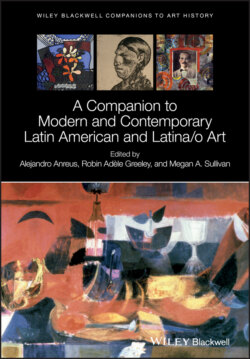Читать книгу A Companion to Modern and Contemporary Latin American and Latina/o Art - Группа авторов - Страница 33
2.1 1922
ОглавлениеIn 1880, just over forty years prior to Brazil's famed 1922 Semana de Arte Moderna (Week of Modern Art, subsequently “Semana”), the central cultural and political questions of Brazilian public debate could be summarized as such: Should the nation abolish slavery or not? How does Brazil become part of the “concert of nations” and adhere to the concept of an industrialized labor force that is modern and free? Are the necessary political structures for a free and modern nation to be found in a monarchy or a republic? Culturally, are Brazilians mere copiers of foreign ideas and forms, as the poet Sylvio Romero suggested? Or, on the contrary, are Brazil's citizens incapable of copying, as the novelist Machado de Assis claimed, and therefore condemned to invent and adapt forms and ideas?
The remarkable historical proximity, rarely noted, between 1880 and 1922 demonstrates how retrograde conditions in Brazil were, as well as how rapidly they could accelerate. The modernists, all of whom were born between the late 1880s and early 1890s, were more the progeny of these past debates than they were apostles of the changes brought on by modern industrial civilization. In other words, they had perforce to contend both with a recent past that had yet to fully fade and with the delayed arrival of the new.
These contradictions and continuities are as much at the heart of the history of the 1922 Semana as they are of the history of Brazil. From the perspective of culture, therefore, the Semana de Arte Moderna is a crucial historical “fact” of modern Brazil. As a result, the event has taken on a life of its own in the subsequent history of the twentieth century. It has been invented and un‐invented, loved and hated, reconstructed and deconstructed at all of those moments in which the history of modern Brazil, with all of its utopias and dystopias, has emerged as an urgent topic of the day or, alternatively, been hidden away in the darkness of night.
The Semana de Arte Moderna, by general consensus, is understood to have been a performance that took the form of an aristocratic guerilla act by antibourgeois bourgeois youth.
As is well known, the Semana was an interdisciplinary set of lectures, poetry readings, concerts, and art and architecture exhibitions staged on the centennial anniversary of Brazil's independence from Portugal. Organized by the poet Mário de Andrade and the painter Emiliano di Cavalcanti, with the participation of writers Oswald de Andrade, Paulo Menotti Del Picchia, and Sérgio Milliet; the painters Anita Malfatti, Tarsila do Amaral, Lasar Segall, and Vicente do Rego Monteiro; the sculptor Victor Brecheret; and many others, the Semana is broadly considered the beginning of modernism in Brazil. Through a rebellious and antagonistic series of events and performances, and through its print mouthpiece, the journal Klaxon (1922–1923), it sought to overthrow the stale aesthetic practices of the country and initiate a new art for Brazil (Figure 2.1).1
Yet those agreed‐upon facts have been inflected both positively and negatively. Almost no one, including the participants, has denied the fact that the Semana was born to become a myth, to be created and recreated, to have a remarkable and transformative character. From the beginning, then, the battle over the meaning and repercussions of the Semana was meant to continue well after those days in February 1922. Perhaps more important than the events themselves were their complex afterlives, which would be continually revisited and reevaluated, along with the idea of modernity itself, throughout the subsequent century.
Figure 2.1 The cover of Klaxon issue no. 1, 15 May 1922.
Source: Reproduced with permission from Biblioteca Brasiliana Guita e José Mindlin.
As such, there cannot be a history of the Semana that is not also a history of the Brazilian century that contained it – of how that century thought about its origins and its myths. The history of the Semana de Arte Moderna is also a war of interpretations and affirmations that were reborn every time its events were scorned or celebrated, particularly on its ten‐year anniversaries. If, on those days in February, the rowdy and aggressive response of the audience was as much a part of the performance as what occurred onstage at the Teatro Municipal or in the salons of modern art, every time the Semana of 1922 was spoken of, this act repeated itself. This continued at least until the moment when, in the 1980s, the Semana began to stabilize as a purely historical event (or as material for the academic market). Since then, it has been commemorated less and less effusively, even as it remained a phantasmagoria haunting the dreams of the living.
The Semana has been sacralized as the symbol‐event of the modern and reformist mentality of Brazil. To invoke this today is as valid, and as banal, as repeating the idea that the days of February 1922 were equivalent to those of Russia's October 1917. What is crucial to note is that the history of the Semana is the history of our century: a questioning of who we are and where we are going. What we know without a doubt is that the participants started to write the history of their founding event by selecting the points to be privileged, which have since become the points to be affirmed or negated. From there, the Semana de Arte Moderna became an official occurrence and would be retold and reinvented according to the interests and needs of each epoch in which Brazil had to (re)think its modernity. This is what we see in the following account, through an analysis of the historical afterlives of the Semana, its myth, and its commemorations and transformations.
